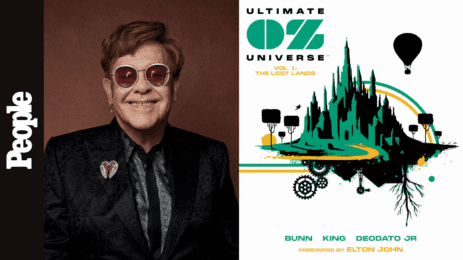By Leslie Katz, Forbes

In the new comic Death Ratio’d, a dark satire of social media’s ever-tightening hold on our psyches, “likes” and “dislikes” determine whether you live or die.
The horror-comedy is set in 2046 in a dystopian Boston, where a man named Arnold Lane wakes from a 22-year coma to find a startling new reality in which people express approval or disapproval for fellow citizens via likes and dislikes delivered from a handheld clicker to the mandatory neck collar everyone wears to register reactions to them. Say something rude, for example, and others can express their annoyance by downvoting you.
When the ratio tips toward too many dislikes, the device detonates, taking the wearer’s head with it. In one scene, a poor guy is relaxing on a park bench when his head suddenly pops off, putting a serious damper on his afternoon.
In this world ruled by social media conventions, one dislike alone can’t do much damage, Death Ratio’d writer Mark Russell said in an interview from his home in Portland, Oregon. “The problem,” he said, “is that in aggregate, these dislikes have the power to blow that person’s head off. Which I think is the danger of social media, that our actions collectively combine into a sort of dogpile that’s maybe more than we intended with our one tiny rebuke.”

Russell’s past comics include Not All Robots, which imagines a future where robots have replaced humans in the workforce. Death Ratio’d presents a similar vision of technology taken to its extreme.
Arnold falls into a coma while an MIT grad student in genetic engineering working on climate-adapting crops and trees. In the comic’s city of the not-too-distant future, Arnold quickly learns that carefully curating words and behavior to avoid death by dislikes can add up to a precarious dance.
The Serbian artist who goes by the name Laci illustrated the comic, rendering much of the futuristic world in cool blues, greens, purples and grays that suggest detachment and foreboding. In Laci’s hands, Arnold’s face conveys confusion, terror and defiance with equal urgency. The artist wanted to work with Russell on the story, he said, because despite taking place 20 years from now, its themes feel so relevant today.
“My relationship with social media is ambivalent at best,” Laci said over email.
Social media might not make our heads disconnect from our necks. But it can lead to explosions of a different sort, causing distress to those who equate follower counts and likes with self-worth, damaging public images and costing jobs, among other ill-fated repercussions.
“In a lot of ways, it has sort of become the justice system for people,” Russell said. “People who were never able to be prosecuted criminally are able to be canceled or hounded through social media. It’s not entirely a bad thing that we have social media for that reason because it allows us to do an end run around nonresponsive institutions. However, there are consequences to partaking in this mass consciousness.”
‘Modulating Ourselves And Our Originality’
Russell, who uses social media daily, knows those consequences well. He said he regularly finds himself checking and changing what he wants to say on social media to sidestep being misinterpreted and misunderstood.
Such mental gymnastics, however, hardly guarantee anyone’s safety in a world where a social media quip can proliferate instantly and easily be taken out of context.
“If you try to say something nice about waffles, somebody will inevitably ask you why you hate pancakes,” Russell said. “We censor or couch our thoughts trying to preempt this sort of criticism, and that’s not a healthy thing. It’s not a healthy thing for us to be modulating ourselves and our originality to answer any sort of critique that could possibly arise.”
Death Ratio’d, out May 29 from New York-based entertainment studio AWA (Artists, Writers, Artisans), is a self-contained comic, known as a “one shot,” that tells its entire story in 48 pages. It will be available for $6.99 online and where comic books are sold.
Russell, who’s read comics since childhood (Mad Magazine got him started), views the medium as ideal for satire and social commentary “because you can get away with more.”
“Because the investment in comics is so much lower than it would be in TV and film,” he said, “you can get things approved and get stories out there that wouldn’t necessarily be approved in those other more expensive media.”
The author views the story of Death Ratio’d as both a cautionary tale and a “maybe-too-late tale.”
“We’re probably locked into this roller coaster,” he said. “I just want people to be cognizant of what’s happening.”
For more information on Little Black Book and other series, visit AWA Studios on Facebook, Twitter, Instagram, YouTube, and AWAStudios.com.
Latest News
Latest News
Trending Titles
Bold Original Stories Spanning Genres















